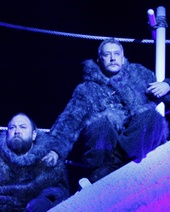SITE GUIDE
SEARCH
REVIEWS
REVIEW ARCHIVES
ADVERTISING AT CURTAINUP
FEATURES
NEWS
Etcetera and
Short Term Listings
LISTINGS
Broadway
Off-Broadway
NYC Restaurants
BOOKS and CDs
OTHER PLACES
Berkshires
London
California
New Jersey
DC
Philadelphia
Elsewhere
QUOTES
TKTS
PLAYWRIGHTS' ALBUMS
LETTERS TO EDITOR
FILM
LINKS
MISCELLANEOUS
Free Updates
Masthead
Writing for Us
A CurtainUp  London Review
London Review
 London Review
London ReviewFram
|
We shared our warmth despite the hostility we felt.— Fridtjof Nansen
|

Mark Addy as Hjalmar Johansen and Jasper Britton as Fridtjof Nansen
(Photo: Nobby Clark) |
With playful self-referentiality, Fram grapples with the problem of men’s suffering and its relation to the arts. Although I left the theatre perplexed at the multiple, elusive meanings, the play never felt pretentious and the odd off note is easily forgiven.
The play opens as Gilbert Murray (Jeff Rawle), Regius Professor of Greek at Oxford in the early 20th century and the author of popular verse translations of Greek tragedies, rises from his tomb in Westminster Abbey with the intention of creating a play about his friend, the explorer and League of Nations associate, Fridtjof Nansen (played by an almost unrecognisable Jasper Britton with glacial blue eyes and peroxide blonde hair). With his favourite leading lady, Sybil Thorndike (Sian Thomas), to help him, he recreates Nansen’s Arctic expedition to the North Pole with his "drunk, depressive, suicide" companion, Hjalmar Johansen (a befurred and cynical Mark Addy). After their survival in the most inhospitable conditions, Nansen completes a further journey alone from egocentric, heroic adventure to becoming a figurehead for charitable work in the face of the world’s famine and poverty.
The elaborate set design follows the sweeping plot with equal flair. Cinematic sequences recreating the South Bank in its entirety, a polar world with the gargantuan ship Fram rising from the ice and a New York theatre complete with red velvet boxes are just a few examples of the varied, spectacular sets.
What, you might ask, is the connection between this classical scholar chiefly known for his Swinburne-esque translations of Attic drama, which passed out of fashion almost a century ago, and an explorer turned humanitarian whose deeds have also been superseded by subsequent generations. Harrison’s skill is in bringing these two characters and the manifold elements together through the thematic exploration of humanity, suffering and the efficacy of the arts. Appropriately enough, there are numerous plays within the play and other ekphrases, including a ballet portraying the Northern Lights and Nansen’s series of lectures. There is also a lengthy debate on the power of propaganda films versus the power of language, persuasion and imagination. Whilst the one manipulates audiences with the pretence of reality, showing shocking yet staged images of the famine, the other is vividly demonstrated by Thorndike’s quite remarkably compelling portrayal of a starving Volga woman forced into cannibalism.
The paradox at the heart of the debate is also central to the play: the artistic expression of inexpressible suffering. A Greek tragic mask, often cradled by Murray, is a recurrent motif (linked to Edvard Munch’s Scream) and symbolises the witnessing and expression of horror. The formalised screams of pain common to Greek Tragedy (such as aiai, ototoi, oimoi etc) are compared to Murray’s woefully inadequate translations of such cries as Alas or Woe is me. At one point, a silenced Kurdish poet refugee with eyes and mouth sewn shut stumbles into Westminster Abbey, representing an inversion of the mask and the failure of poetry against the human rights abuses of the world. Nevertheless, he is spurned by Murray who cares more about his own petty egoistic jealousy of his rival T.S Eliot. Smashing the tragic mask, Murray is relegated at the end as his own play within the play disobeys its constraints and has the last word over him. The human coda returns to Nansen’s journey on the ship Fram where it is revealed that it was not the Darwinian vision ("with the emphasis on win") which got Nansen and Johansen through the harsh winter at the North Pole, but the human warmth of sharing the same sleeping bag in spite of their personal enmity. With Nansen’s dystopian conviction that ice will take over the world, this essence of humanity is our only hope for salvation.
Fram is stimulating, exhilarating and meaty, with complex layers of metatheatre and art and a tragic vision for the 21st century with its roots in ancient drama. Harrison’s immensely speakable and energetic verse engages with the modern world’s problems and tentatively suggests an answer.
|
Fram
Written by Tony Harrison Directed by Tony Harrison and Bob Crowley With: Jeff Rawle, Sian Thomas, Jasper Britton, Mark Addy, Viviana Durate, Jim Creighton, Steven Helliwell, Joseph Thompson, Patrick Drury, Carolyn Pickles, Clare Lawrence, Aykut Hilmi, Ronald Chabvuka, Joel Davis, Verelle Roberts, Keanu Taylor Set Design: Bob Crowley Costume Design: Fotini Dimou Lighting: Mark Henderson Music: Richard Blackford Choreography: Wayne McGregor Running time: 3 hours with one interval Box Office: +44 (0)20 7 452 3000 Booking to 22nd May 2008 Reviewed by Charlotte Loveridge based on 28th April 2008 performance at the National Theatre, South Bank, London SE1 9PX (Rail/Tube: Waterloo) |
|
REVIEW FEEDBACK Highlight one of the responses below and click "copy" or"CTRL+C"
Paste the highlighted text into the subject line (CTRL+ V): Feel free to add detailed comments in the body of the email. |
|
London Theatre Tickets Lion King Tickets Billy Elliot Tickets Mighty Boosh Tickets Mamma Mia Tickets We Will Rock You Tickets Theatre Tickets |




